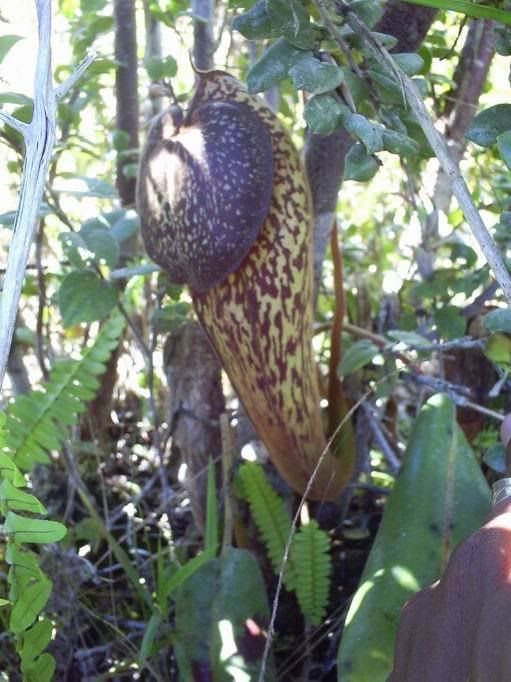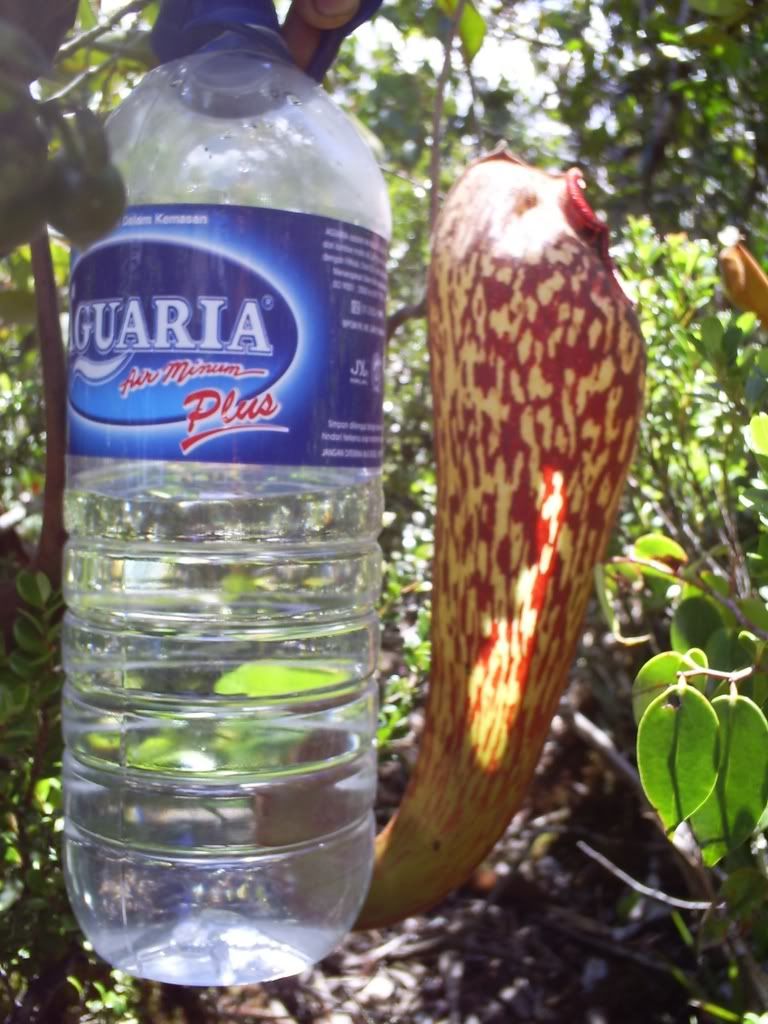|
|
Post by longor on May 17, 2008 23:03:52 GMT -10
Klossii follow up My friend from papua returned to the area to look for more locations. here are some photos of Klossi from other locations, fortunately he manage to find a few other location safe from "progress".  without the lid  Aqua bottle for size comparison  klossii X Maxima (notice how small the pitcher is compared to the true species)  From what I gather, Klossii grows on small patches of open vegetation throughout the area, every population that were found only has 5-6 mature plants, with lots of maxima around. |
|
|
|
Post by sockhom on May 17, 2008 23:34:38 GMT -10
Some locations safe from progress? Fantastic Longor.
A big thanks to your friend!
Did he find more plants than in the previous location? I understood he only found 5/6 plants per location but does that make a good number of specimens?
François.
|
|
|
|
Post by longor on May 18, 2008 0:37:07 GMT -10
he saw about half a dozen locations scattered throughout the area. on average there is about 5-6 plants per location. so in total a few dozen mature specimen.
from personal communication, another person who has located klossii said that the most that he ever saw from a single population was 15 mature plants.
Cheers
|
|
|
|
Post by sockhom on May 18, 2008 1:35:22 GMT -10
So its reputation of being an extremely rare plant is not overrated.
You guys have made the report of the year. Thanks again for the contribution.
François.
|
|
|
|
Post by rainforest on May 26, 2008 8:16:17 GMT -10
I am intrigued that very few/none of their seedlings are found. Do you think that these plants have had a bad year(s) of drought or other external factors preventing proliferation of their kind? Normally we will find seedlings of varying maturities growing near adult plants. Look at N. rajah where people have shown an abundance of seedlings all along a trail among larger specimens.
Having seen so many hybrids with N. maxima, one wonders if N. klossii as a true species may be going out and introgressing with maxima as the obligate species. But perhaps we haven't come across to a location where the opposite is occurring.
What prey items are found in N. maxima? Are they in competition for the same prey?
M
|
|
|
|
Post by vraev on May 26, 2008 20:05:11 GMT -10
Here's fingers crossed for hope that this plant can soon be introduced into cultivation. IMO it looks better than an aristolochioides and seems to be an interesting member of this highly active genus.
|
|
|
|
Post by justlikeapill on Jun 7, 2008 20:59:23 GMT -10
I appreciate your work. It pains me that you can not remove the plants instead of having them destroyed, but these things happen. It pains me that humanity hasn't advanced as a species beyond warfare that makes it so difficult for someone as innocuous as people on an expedition to see a plant. Seriously... plant "hunters".
I hope that within my lifetime, I'm able to grow this species. I hope I am able to grow N. klossii x aristolochioides or the reciprocal, for that matter. I hope we all are. Now, if you'll excuse me, I'm off to fantasize of future ethereal hybrids.
|
|
Robiii
Nobiles
   Grow the new world
Grow the new world
Posts: 262
|
Post by Robiii on Dec 28, 2008 23:10:51 GMT -10
I have seen places almost an exact replica of N. klossi habitat here on on Oahu and I'd guess there'd be similar places on the surrounding islands. Still I stare with a glazed lured haze as it draws me in as I were it's prey. Great report longor! Thank you angain for this post and in habitat photograghs.
Rob
|
|
|
|
Post by sdcarnivores on Mar 12, 2009 18:34:19 GMT -10
I hope somebody collects seeds of this plant before it goes extinct in the wild.
|
|
|
|
Post by justjack604 on Nov 1, 2009 14:51:47 GMT -10
May be older but this is an awesome thread. Being able to distinguish the sexes I'm sure there were cuttings of both taken. Too bad someone can't take pollen and properly store it just to return and get tone of those girls pregnant as can be, to help change the curve.
|
|
Dave Evans
Nobiles
   dpevans_at_rci.rutgers.edu
dpevans_at_rci.rutgers.edu
Posts: 490
|
Post by Dave Evans on Nov 4, 2009 12:09:19 GMT -10
Yeah really, that sounds like a good plan, but rather difficult to pull off. Stored pollen from multiple growers has never worked for me. Not even pollen I stored myself.
Has stored pollen ever worked for anyone? If so, how long was it stored for and how?
|
|
PHaze
Urceolatae

Posts: 15 
|
Post by PHaze on Nov 4, 2009 14:44:40 GMT -10
Stored pollen can work. Here's a thread where several people report success storing pollen from several months to a year. pitcherplants.proboards.com/index.cgi?board=general&action=display&thread=7495&page=1The March 2006 issue of CPN has an article documenting an experiment on N. ventricosa pollen storage. After subjecting pollen to various forms of storage, they checked its viability by sprinkling it on sugar water and using a microscope to check for formation of a pollen tube some time later. They found several interesting things. - Pollen harvested at night was much more viable than pollen harvested during the day.
- The pollen required light to germinate
- Viability dropped off very quickly at room temperature/humidity, and was virtually nil by the 8th day.
- Viability dropped off quickly for pollen stored in water, regardless of whether it was stored at room temperature, 3C, or -18C.
- Pollen which was dried with a desiccant and stored at -18C for 10 months had a 40% germination rate.
- Pollen kept at -196C for 20 hours and pollen kept at -80C for over a month showed no reduction in germination rate.
|
|
Dave Evans
Nobiles
   dpevans_at_rci.rutgers.edu
dpevans_at_rci.rutgers.edu
Posts: 490
|
Post by Dave Evans on Nov 4, 2009 19:24:46 GMT -10
Thanks-you PHaze,
I believe it about the pollen being more viable at night. Nepenthes flowers emit much more odor at night, so I think their pollinators must be night time insects.
Pollen which touches water rots very quickly. It rots if the humidity is too high.
But, who has a fridge that goes to -80 degrees?
|
|
PHaze
Urceolatae

Posts: 15 
|
Post by PHaze on Nov 5, 2009 8:00:52 GMT -10
I think you're right about the night time pollinators. The article even mentioned that the pollen viability was positively correlated with amount of odor and nectar emitted by the plant and all increased at night. They also mentioned that this diurnal timing may not hold true for all Nepenthes and may vary across species. This makes sense since Nepenthes are found in such varying habitats. Surely the pollinating species are not the same in all cases.
I doubt many individuals have access to a freezer capable of -80C, but they are not uncommon in university biochemistry labs. I imagine various types of medical facilities uses these freezers as well. Heck, there's one for sale on ebay right now for 2800 USD. Not too practical, but it's nice to know that long term storage is at least theoretically possible.
|
|
|
|
Post by richjam1986 on Nov 24, 2012 7:00:06 GMT -10
I Loved the field report! Thanks for sharing  |
|